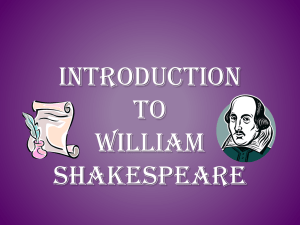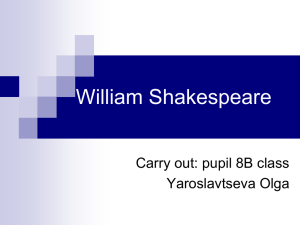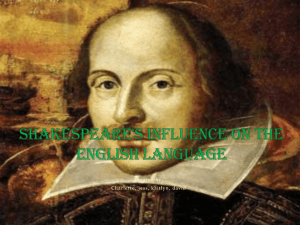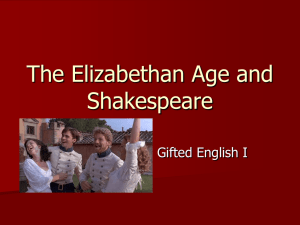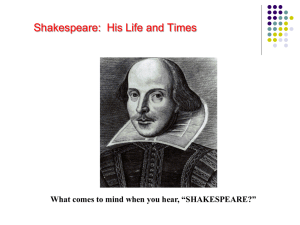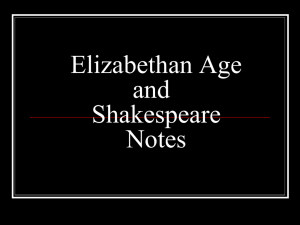Shakespeare Toolbox - Ginger Stone English III-AP and IV-CN
advertisement
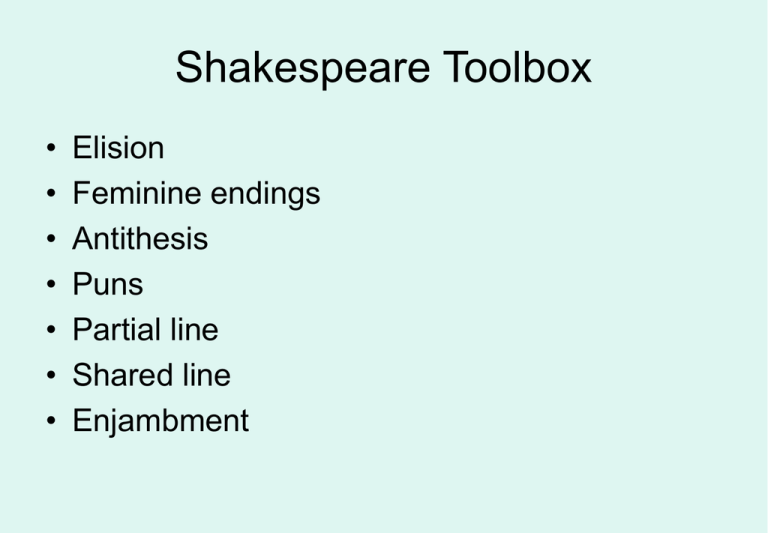
Shakespeare Toolbox • • • • • • • Elision Feminine endings Antithesis Puns Partial line Shared line Enjambment Shakespeare Toolbox Elision: squeezing words to fit the scansion (meter); often utilizes an apostrophe to indicate the “missing” syllable o’er = over sev’n = seven e’er = ever heav’n = heaven Shakespeare Toolbox Elision But you don’t always need an apostrophe... “O Romeo, Romeo, wherefore art thou Romeo?” ro-me-o OR rome-yo ? (that is the question) Shakespeare Toolbox Feminine endings: an extra, unstressed (or soft) 11th syllable at line ending used to emphasize the word at end We will see this effect during Hamlet’s big “To be or not to be” speech. Shakespeare Toolbox Antithesis: a clash of opposites; found everywhere in Shakespeare “To be or not to be…” (To live or to die…) Or perhaps something more modern: “Ask not what your country can do for you, ask what you can do for your country.” Shakespeare Toolbox Puns: word play From Richard III: “Now is the winter of our discontent Made glorious summer by this son of York.” Can you find the antithesis and the pun? Shakespeare Toolbox “Now is the winter of our discontent Made glorious summer by this son of York.” Winter/summer = antithesis Son = sun (What makes it summer? The sun. That is so punny.) Shakespeare Toolbox Partial lines: don’t ignore the “silent” syllables or beats; it’s a pause used for emphasis (like the “pregnant pause”) Shared verse line: two characters sharing the iambic line; used during quick, tense conversations Shakespeare Toolbox Example of a partial line: (from Hamlet) Laertes: He is justly served. (actor pauses 5 beats before speaking line) Example of a shared line: (from Hamlet) Laertes: My lord, I’ll hit him now. Claudius: I do not think’t. Shakespeare Toolbox Enjambment: don’t pause at line endings unless there is punctuation indicating to do so • (hint: the “b” is silent) Shakespeare Toolbox “Brilliant Elizabethan Fallacy”: In the 1600s, most people didn’t speak like Shakespearean characters – not even Shakespeare. But our TV and movie actors don’t speak exactly like we do in everyday conversation, either (ums, like, uhhs, grammar errors deleted). Everyone sounds smarter than they really are (“heightened language”). Shakespeare Toolbox Think Like an Actor Why are some of the words mixed up or out of order? Didn’t Shakespeare understand basic grammar? Energy builds towards the line ending, so he placed key words there (for emphasis). Shakespeare Toolbox Think Like an Actor Why did Shakespeare use such a high level of vocabulary if most people were illiterate anyway? He “created” words by combining the (leapfrog), using nouns as verbs, or using sounds of words creatively for effect. In fact… Shakespeare Toolbox Think Like an Actor Shakespeare’s vocabulary consists of over 17,000 words – four times the average person’s vocabulary. The Oxford English Dictionary credits him for the derivation of over 3,000 words. Approximately 7,000 words are used only once. Shakespeare Toolbox Think Like an Actor That character’s comment sounded naughty! I thought Shakespeare was supposed to be intellectual and “high culture.” Did he just make a double entendre? Yes. Shakespeare Toolbox Think Like an Actor Why does he repeat himself so much? Because he wants to make sure you get it. If you hear something over and over, it ‘s important. Remember, there is no rewind in theatre. Shakespeare Toolbox Think Like an Actor “Repeats” can be done two ways: 1. a word is used many times by various characters throughout the course of the play: R&J – love, Hamlet – ear, Othello – handkerchief (all items relate directly to the plot or theme) 2. a character says a word repetitively in the same line: Hamlet – “words, words, words…” Shakespeare Toolbox Think Like an Actor Argh, I don’t understand! Take a blank piece of paper and cover up the lines. Go line by line, moving the paper down. Don’t move down until you understand each line. It’s slow, but it works. Shakespeare Toolbox Think Like an Actor Wait, is he being ironic/sarcastic? Yes. Shakespeare Toolbox Think Like an Actor As with the double entendres, it is easier to pick up on the ironic and sarcastic remarks in performance. Shakespeare used them well and used them liberally. Shakespeare Toolbox Classification by Genre Four Basic Genres of Shakespeare: – Comedies – Histories – Romance – Tragedies Shakespeare Toolbox Classification by Genre Characteristics of Shakespeare’s Comedies: disguises, cross-dressing thwarted love mistaken identity romantic misunderstandings ends with multiple marriages Shakespeare Toolbox Classification by Genre Characteristics of Shakespeare’s Histories: conspiracy fighting, war sub-plots involving non-nobles a decisive on-stage battle Shakespeare Toolbox Classification by Genre Characteristics of Shakespeare’s Romances: natural disasters unlikely coincidences conflict between generations and w/in families unforeseen conclusion in which forgiveness and reconciliation are achieved against all odds Shakespeare Toolbox Classification by Genre Characteristics of Shakespeare’s Tragedies: action revolves around a single heroic figure a dreadful dilemma or a horribly wrong decision fighting and madness many deaths at the play’s end Understanding Shakespeare’s Tragedies (before you open a vein) 1. Protagonist’s downfall affects many people (or an entire country). 2. His downfall is a result of a personal error in judgment (hamartia) or excessive pride (hubris) 3. Protagonist must be essentially good for us to care. 4. Audience becomes aware that even the most powerful individuals can destroy themselves through their imperfect understanding of the human condition.
